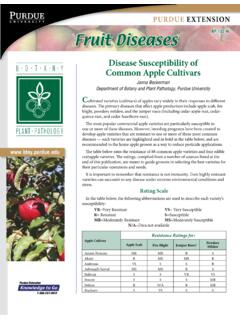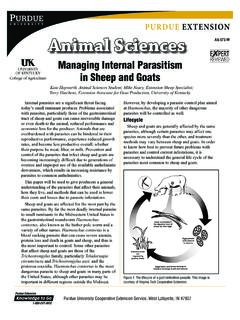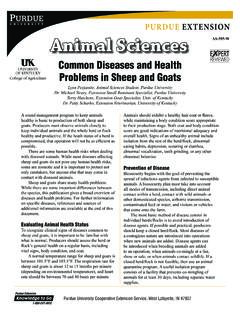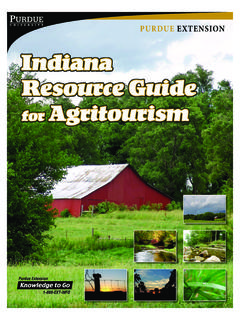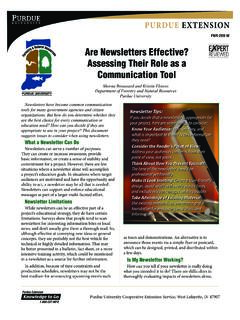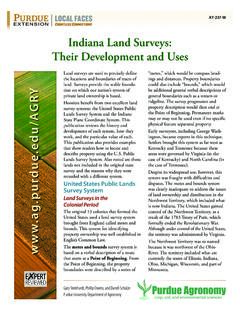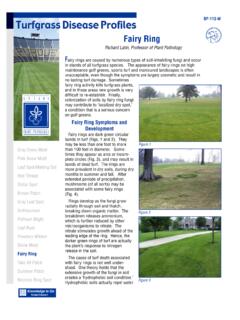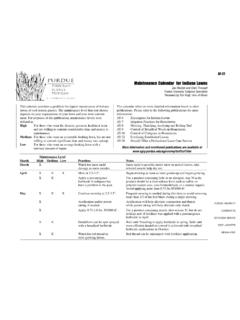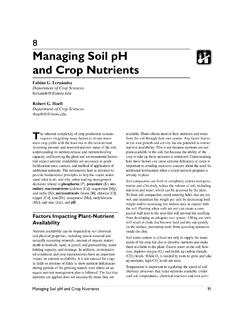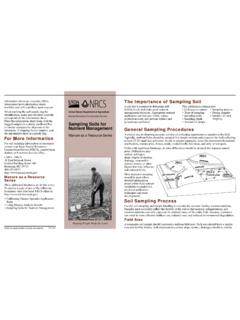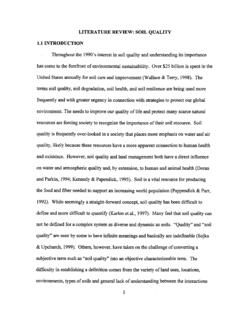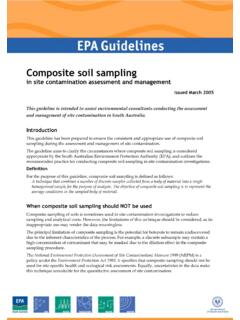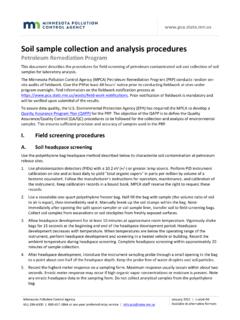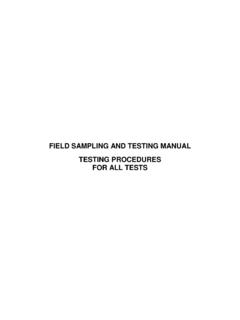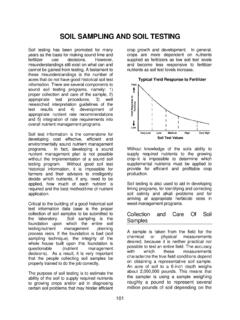Transcription of Soil Sampling Guidelines - Purdue Extension
1 Author: Jason P. Ackerson,Assistant Professor of AgronomyAY-368-WSoil testing is an integral part of a soil fertility management program. Effective soil testing provides information on the fertility status of soils within a field that can be used for making fertilizer or lime application recommendations, monitoring changes in soil fertility over time and even identifying and targeting low fertility soils within larger fields. Informative soil Sampling can improve on-farm nutrient efficiency, leading to increased return on investment for fertilizer and lime application and decreased risk of off-site nutrient movement. Regardless of the goal, reliable soil testing starts with proper soil Sampling . In this article, we will outline the basic principles of agronomic soil Sampling , covering the basic principles of soil sample collection and providing Guidelines for establishing an effective soil Sampling and testing Collection and HandlingProper soil sample collection relies on three principles:1.
2 Organization: having an orderly system for soil sample collection and handling simplifies sample collection and minimizes the chance of human errors such as mislabeling or misplacing soil Consistency: collecting each sample in a uniform manner between years and within the course of a Sampling event will greatly improve the quality and reliability of your results. This means taking samples in the same manner for each sample. 3. Simplicity: following simple procedures will help ensure sample collection is consistent and easily Sampling Guidelines2AY-368-W soil Sampling GuidelinesSamples and subsamplesSoils can be highly variable, even over short distances. Because of this variability, it is often insufficient to collect soil at just one location. Instead, it is preferable to collect so-called composite samples.
3 composite samples are a mixture of individual samples, or subsamples, generally collected from multiple locations and mixed together to form a single composite sample. By combining multiple subsamples into a single composite sample, we can minimize the effects of soil variability by averaging the soil properties over larger areas. composite samples are less sensitive to unusually high or low soil test values that might occur due to concentrated fertilizer applications ( banded applications) or natural soil collectionBefore collecting soil samples, you will need to gather certain materials and tools: A soil probe A clean plastic bucket A trowel Permanent markers Sample bags. Many soil testing laboratories will provide wax-lined sample bags. In lieu of laboratory-provided bags, consider using paper bags or zip-top bags.
4 Clipboard and paper or field notebook GPS-enabled smartphone or handheld gps unit (optional)To collect a composite sample use the following procedure:1. Before arriving to the field, determine the number and approximate location of soil samples. (See the Sampling locations and strategies section for details.)2. Once the appropriate materials have been collected, travel to the first Sampling location. If you d like, you may record the location with a GPS or GPS application on your smartphone. This information can be useful later for tracking where samples have been collected. You may find it helpful to return to the same Sampling locations in subsequent Sampling events. 3. At the sample location, remove any crop residue from the soil Insert the soil probe to the desired depth. (See Table 1 for details on sample depths.)
5 Take care to ensure the probe is inserted vertically into the soil and not tilted to the side. Remove the probe and transfer the soil core from the probe into a bucket (Fig. 1).Figure 1. Collecting a soil sample with a soil probe. Insert the probe vertically into the soil and remove the soil core. 5. Move to a new location and repeat Steps 3 and 4. The distance between locations where you collect subsamples will vary depending on the Sampling strategies you are employing. (See the Sampling locations and strategies section for more info.) As a general guideline, the larger the area of land you are Sampling , the more distance you need between Sampling locations. As a rough guideline, Sampling locations should be separated by a minimum of 20-30 feet. If employing a zone-based or grid-based soil Sampling program, it is often worthwhile to select the location of soil samples prior to arriving in the field for Sampling .
6 These preidentified points can be loaded onto a GPS-enabled device and the GPS can be used to direct you to the Sampling location. 6. Continue this process of sample collection at new locations until you have collected a sufficient number of samples. Typically, a composite sample should be comprised of between 10 and 20 subsamples. The more subsamples you add into a composite , the more reliable a sample becomes. 3AY-368-W soil Sampling Guidelines7. Using the trowel, thoroughly mix the soil in the bucket until you have a homogeneous mixture. 8. Place 1-2 cups of the mixture into a sample bag. Using permanent marker, label the bag with a unique name. Names should contain identifiers to the field and sample number. For example, Smith-Field1-1 is a good label that identifies the farm (Smith Farm), field (Field 1) and the sample number (1).
7 Table 1. Sample depth guidelinesTillage SystemSample depthConservation tillage (Less than 50% of crop residue incorporation)Take separate samples: 0-4 inches for pH/liming recommendations 0-8 inches for fertility analysisConventional tillage (Greater than 50% of crop residue incorporation)0-8 inches for pH/liming recommendations and fertility analysis Sample HandlingAfter collecting a composite sample, it is important to properly store samples to prevent contamination. Typically, most laboratories prefer to prepare samples in their lab. This means that you can often send samples directly to the laboratory without doing any processing yourself. Some laboratories require samples to be submitted in specific sample bags or containers. Check with your chosen laboratory for specific information on its requirements for handling and packaging samples.
8 If you are not sending samples directly to the laboratory, consider storing samples in the refrigerator or freezer to minimize the chance of mold forming in the sample bag. If the soil is excessively wet or you cannot store samples in a refrigerator/freezer, allow the samples to air dry slightly by spreading the soil in a thin layer on a flat surface like a table. You can put down some paper such as used newspaper to protect the surface from getting dirty. Never dry a sample in an oven or microwave; excessive heat can damage the sample and alter laboratory results. soil testing laboratoriesSoil testing is available for a nominal fee through several specialized laboratories. Each laboratory will have specific instructions for how to ship and label samples. To ensure the laboratory provides accurate and timely results, be careful to follow any laboratory-specific instructions.
9 For details on laboratory-specific instructions, contact your chosen soil testing most commercial laboratories provide quality, reliable testing services, there can be differences in methodology and results between laboratories. For this reason, it is often desirable to use the same soil -testing laboratory every year. This will ensure that any observed change in soil -test results from year to year are attributable to true changes in soil fertility status and not due to deviations in testing practices between different laboratories. Sampling locations and strategiesDetermining where to take soil samples depends largely on the management strategy you employ on your farm. These management strategies can be broken down into two types: whole-field and spatially explicit (Fig. 2). In a whole-field management the field is managed as one unit.
10 When fertilizer is applied in a whole-field approach, one fertilizer rate is applied uniformly across the entire field. Whole-field management is simple to implement and does not require any special equipment or data spatially explicit management, the field is broken into smaller sections, and each section is managed individually. Spatially explicit management can identify areas of the field with specific fertilizer of liming needs and provides a map of a field s nutrient and liming requirements. Spatially explicit management is an essential part of precision agriculture. In spatially explicit management, variable-rate technology can be used to alter fertilizer and lime applications so that each zone receives a targeted, zone-specific fertilizer or lime soil Sampling GuidelinesUltimately, the decision between whole-field and spatially explicit management will depend on the specific goals and constraints of each operation.
